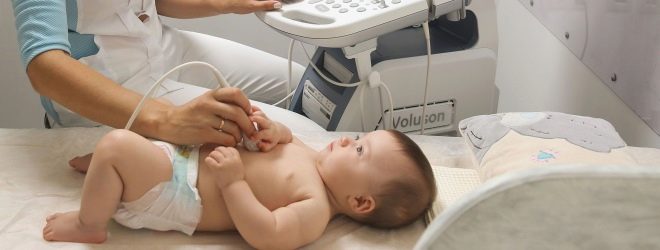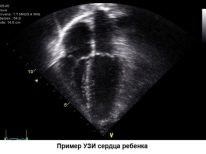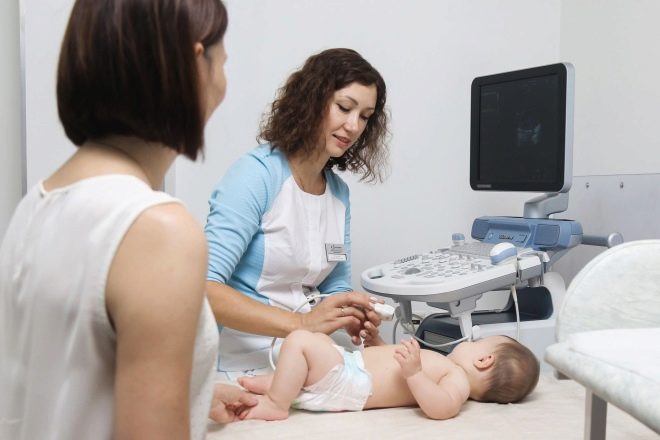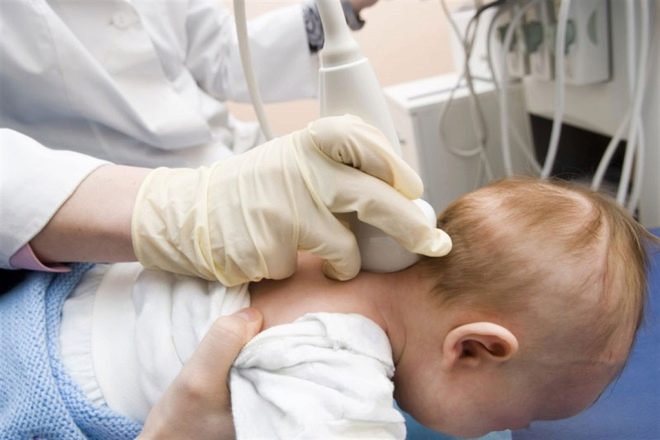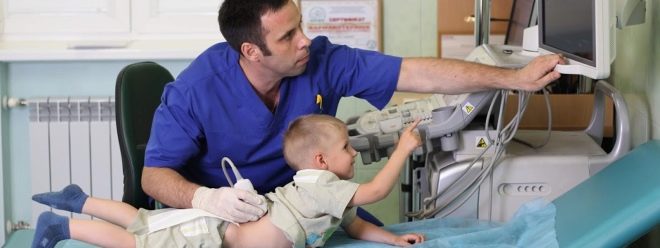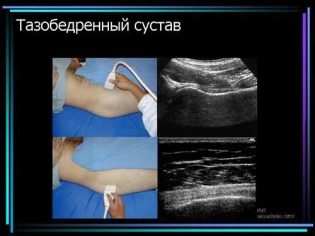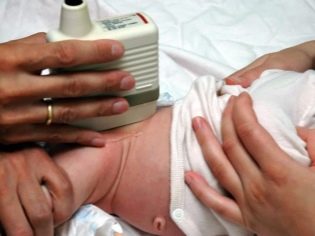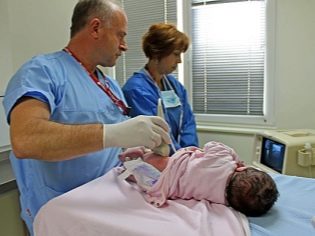Kinds and features of children's ultrasonography
Ultrasound is a fairly common method for diagnosing various diseases and conditions in childhood. It allows non-invasive way to get enough informative results. Ultrasound does not have any age restrictions, and therefore is carried out both for a newborn in the maternity hospital and for infants at any time during their life, both for medical reasons and as part of a comprehensive screening study.
About what types of children's ultrasound are that they can show how to prepare the child for ultrasound diagnosis and whether it can cause harm, we will tell in this material.
The essence of the diagnosis
Ultrasound was taken into service by physicians just over 20 years ago. The essence of the method consists in the ability of ultrasonic waves to be differently reflected from different media - liquid or walls of internal organs. Ultrasonic signal generates a special sensor. He also receives the reflected, returned signal and projects the image on the scanner's monitor.
Equipment is always equipped with complex programs that allow you to analyze the image, avoiding long and difficult mathematical calculations. The size of the organs, volume, structure allows you to set with high accuracy special mathematical algorithms incorporated in the program for ultrasonic scanners.
Ultrasound, which produces a black and white image, is called two-dimensional. Sometimes it is necessary not only to inspect something, but also to evaluate the functionality. This need often arises when evaluating the work of blood vessels. Then do an ultrasound with doppler. Duplex study provides a color image. If you wish, you can also carry out a color three-dimensional 3D ultrasound, but such a need is mainly in pregnant women who want to know the gender and look at the appearance of the unborn child. Although three-dimensional ultrasound is not contraindicated for children, in fact, it is not necessary.
Varieties
Ultrasound is divided according to its intended purpose for emergency and planned. Emergency is carried out in order to establish an accurate diagnosis in the presence of objective complaints. Planned research is carried out within the framework of compulsory screening recommended by the Ministry of Health - in 1 month, and then when registering a child in an educational institution. A comprehensive screening study includes an ultrasound of the brain, hip joints, abdomen, bladder and kidneys.
When applying for a school, an ultrasound scan of the heart, abdominal organs, kidneys and bladder is performed on the child. If necessary, ultrasound of the retroperitoneal space and superficial organs - the thyroid gland, thymus gland (thymus gland), etc.
We will tell about main types in more detail.
Neurosonography
NSG is an ultrasound scan of brain structures. Informative research is carried out for children from birth and until the moment they drag on and close on the head of the "spring". The mobility of the cranial bones and the presence of the so-called "springs" allows you to inspect brain structures with a sensor attached to the area of a large "fontan". If an assessment of the blood supply to the brain is required - duplex scanning, an additional sensor is used to examine the cervical spine and the blood vessels of the neck.
The method makes it possible to assess the symmetry of the hemispheres, the state of the cerebral cortex, certain parts of the organ that are important for normal development and functioning. Through ultrasound, ischemia, cerebral hemorrhage, hydrocephalus, ventricular dilatation, neoplasm and edema can be detected. Also, neurosonographic examination is recommended after a fall and hitting the head to exclude traumatic brain injuries.
It should be noted that only based on the results of ultrasound diagnosis is not exposed. But the negative markers found by a specialist in ultrasound diagnostics will be a good reason for appointing a child with a more detailed and more informative examination of the brain - computed tomography, MRI.
Abdominal organs
Abdominal organs are a large list of the most important internal organs. The study assesses the condition of the liver, stomach, gallbladder and bile ducts, esophagus, pancreas, spleen, part of the intestinal loops, large abdominal vessels, as well as the kidneys and bladder.
Not all anomalies, including congenital, immediately manifest themselves. Some in the early stages of the kids do not appear almost nothing, and learn about their presence will be possible only with a careful ultrasound.
Preventive ultrasound aims to eliminate the malformations of internal organs. Then the child may be given this type of study at any time if symptoms such as indigestion, frequent constipation or diarrhea, vomiting, bad breath, impurities in the feces, abnormal urine color and its sharp smell, impaired hemostasis, unexplained weight loss or on the contrary, abnormal weight gain.
Especially shown is the diagnosis of premature babies, babies born with low birth weight or very large babies. Problems with the digestive tract they have, according to statistics, much more often.
This type of ultrasound is characterized by the largest number of medical errors. The internal organs grow, and much depends on the weight and height of the baby, on concomitant diseases, therefore, the baby is often found to have illnesses that are not there, and they also do not see the beginning signs of pathology.
Kidney and Bladder
A healthy child will be enough research on the organs of the abdominal cavity, which include the kidneys and the bladder. But sometimes there are situations when it is necessary to examine the urinary system. If the child has pain when urinating, changes in the amount and color of urine, the appearance of a strong smell from the fluid excreted by the kidneys, when the temperature rises in combination with the above symptoms, as well as if the results of the laboratory urine tests are bad, the doctor will definitely do an ultrasound scan.
The study allows to establish the structure of the kidneys, the pelvis, their possible expansion, the state of the ureters and the bladder. Certain changes in the echogenicity of the organs of the system will allow the doctor to judge the presence of inflammatory processes in a specific place of the urinary system, which will greatly facilitate the task of the doctor who will plan the treatment.
Considering the steady increase in the number of kidney diseases, recently the Ministry of Health decided to add this type of ultrasound scan to a screening study for children. not only in 1 month, but in a year and a half.
Hip joints
This type of diagnosis is also included in the screening of infants, but can also be prescribed outside the routine examination if the orthopedist sees that the baby has problems with the maturation of the joints. Ultrasound allows you to establish the condition of the joint, the correctness of its location relative to the axis, the presence of subluxation, pre-dislocation or dislocation.
If an orthopedist is able to see the general signs of pathology with the naked eye, then an ultrasound scan can reveal the exact degree and form of dysplasia, which is important in therapeutic tactics.
In the case of TBS pathologies, timeliness is extremely important - the earlier the deviations are found, the more favorable the prognosis for complete cure. Late diagnosis in case of refusal of the mother from ultrasound in the framework of screening can lead to disability of the baby.
This type of ultrasound has the greatest value for premature babies, for babies born in families where relatives have joint pathologies, for children who in their mother’s stomach preferred to sit on the priest — were in pelvic presentation, as well as small residents of large cities with poor state of ecology, children with birth injuries and twins and twins.
The sensor during the study is applied to the joints on the right and left, with simultaneous bending of the legs. It is painless and fairly quick.
Other diagnostics
It is difficult to list in a single article all the situations in which an ultrasound scan can be assigned. So, if the boys do not test the testicles, an ultrasound scan of the scrotum is combined with an ultrasound scan of the abdominal cavity and retroperitoneal space to determine the location of the sex glands. Girls can be carried out ultrasound of the pelvic organs in cases of suspected malformations of the internal genital organs, gynecological diseases of an inflammatory and non-inflammatory nature.
If the child is overweight, he may be shown a study of the thyroid gland, and in severe pallor and arrhythmias, ultrasound of the heart and blood vessels is performed.
Parents should be clear about the fact that ultrasound does not provide 100% accuracy. The maximum accuracy of this type of diagnosis is estimated at 80-95%. Therefore, the results of ultrasound - not a sentence, but only the basis for further examination of the child, if there is a need.
Training
Special training is not always required. Children's ultrasound differs from an adult in that the child can not always lie down calmly and give the doctor an opportunity to carefully examine and describe everything. Therefore, the most important preparation is psychological. If the baby is at a reasonable age and can understand what the mom explains to him, you need to tell the crumb that the forthcoming examination will not give him either pain or discomfort. Babies under one year old are best tested during sleep.
Before neurosonography, the child must be fed, fed and satisfied. The chances that such a baby will fall asleep are higher. But abdominal ultrasound is recommended to do on an empty stomach, because in the process of digestion, many organs of the gastrointestinal tract can change their shape and size. The only exception is ultrasound of the gallbladder, which is performed with a load - the child needs to “start” the processes of bile formation and outflow, for which it is recommended to give him a cholerex breakfast - a banana or sour cream.
Ultrasound diagnosis of the bladder requires pre-filling it - the child must be given a mandatory drink 15-20 minutes before visiting the doctor’s office.
No preparation is required before an ultrasound scan of the hip joints, before an ultrasound scan of the scrotum.
In all other cases, doctors recommend one day before visiting a doctor to exclude products that increase the amount and production of intestinal gases - legumes, cabbage, and yeast pastries. Before vascular ultrasound it is undesirable to take antispasmodic drugs, if they are not a mandatory component of the course of treatment prescribed to the child.
Nuances of diagnosis in childhood
From the point of view of the Ministry of Health, there is absolutely no difference between an ultrasound scan for an adult patient and a similar diagnosis for a child. Therefore, doctors who have received an appropriate education can do an ultrasound scan for children.But an important nuance lies in the peculiarities of the physiology of children - their internal organs grow intensively, and therefore the age limit by a doctor who has received a conventional therapeutic education can be perceived as pathology. It is for this reason that it is recommended to do an ultrasound examination of a child in specialized children's medical centers and clinics where pediatricians work.
There are some differences in the equipment itself. For pediatric ultrasound, special pediatric sensors are used - their resolution is high, as is the radiation frequency. Conventional sensors allow you to inspect the internal organ at a distance of up to 30 centimeters from the point of application of the sensor. Children's sensors allow you to see the body at a distance of 15 centimeters, but the quality of the resulting image will be much higher.
The same doctor, even if he is the holder of the highest professional category, is unlikely to be able to evaluate all the internal organs and carry out all types of ultrasound with the same accuracy. So, in specialized children's centers there is a so-called internal specialization - one doctor specializes in neurosonography, and he knows everything about her, and the other is an excellent specialist in the field of heart ultrasound, and his opinion is trusted by the best cardiologists. This is another argument in favor of passing a children's ultrasound scan in special children's medical institutions.
In general, children's ultrasound requires a lot of experience from the doctor, attention, concentration, knowledge of the age features of the development of internal organs, as well as a lot of patience and tact to answer the questions of concerned parents.
Potential harm
This question is the most important for parents. Rumors that the ultrasound is bad sometimes make moms and dads refuse to take the recommended screening, especially screening. When diagnosing, as follows from the description of the essence of the method, neither electromagnetic radiation nor X-ray X-waves are used, and therefore there is no reason to talk about the harm of ultrasound as such.
Information about the danger of diagnosis was not born from scratch - the young method (it is a little more than 20 years old) does not yet have statistical data on the long-term effects of ultrasound. The first children who did an ultrasound scan are now only 20 years old or a little more. In order for evidence-based medicine to obtain evidence of adverse effects, information is needed on the health status of patients in adulthood and old age. While data on the dangers of the method is not. That is why ultrasound is recommended for pregnant women and infants.
Sometimes harm is more from parents refusing to examine a child by this method indeed, the pathology remains unnoticed until it is sufficiently neglected and no symptoms of it appear. So, after a series of official letters from children's oncologists, neurologists, and surgeons who are confronted with such “neglected” cases, the Ministry of Health decided to introduce ultrasound diagnostics into complex screening studies.
About why it is necessary to do ultrasound for children of the first year of life, see below.

